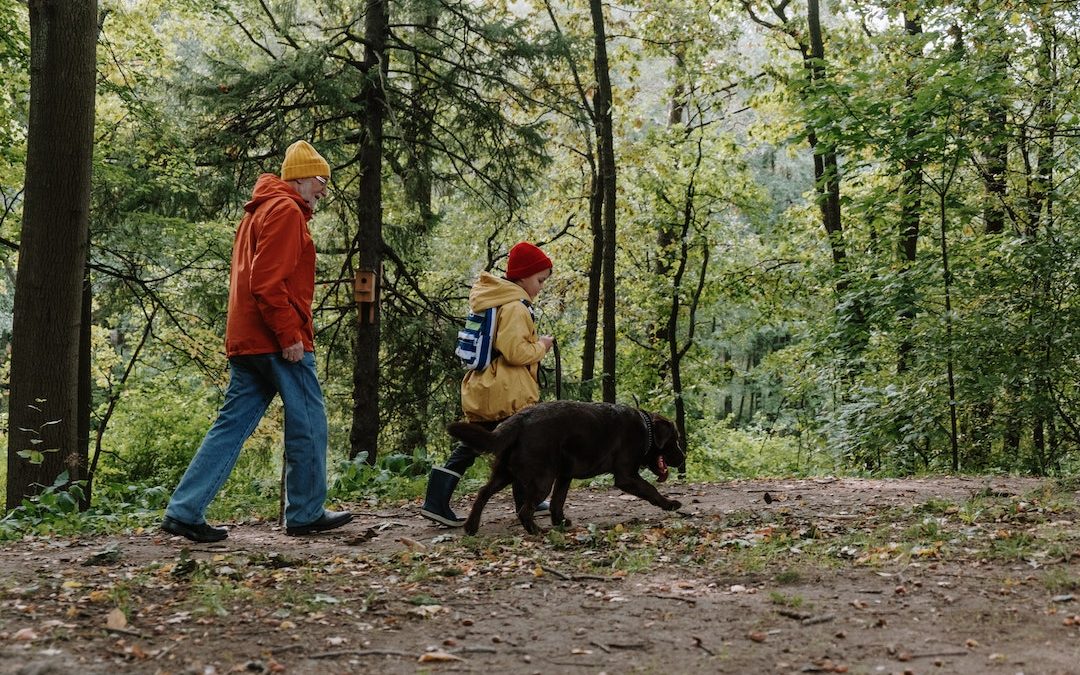By Hezron Kagia, Nina Verhage
Our living lab fieldwork in Heverleebos and Meerdaalwoud took place under unfortunate weather conditions. Despite the pouring rain and low temperature, we still managed to encounter people who were making use of the forest for recreational purposes. These groups had different motives ranging from joggers, cyclists, camping enthusiasts, people taking casual walks and most interestingly, people who were walking their dogs. Conversations with dog walkers indicated that walking their dog was the main reason they left their homes under such weather conditions. In this blog we reflect (scientifically) on the role that dogs play in making people move, their conflicting relationship with nature and what you, as the owner, can do to improve that relationship.
Sedentary lifestyles are becoming a global challenge due to the change of working patterns (people with office jobs and most recently, working from home), lack of spaces for exercise and the rise of passive means of recreation such as watching television and playing video games[1]. Increased sedentary time has been shown to increase the chances of cardiovascular diseases, depression, cognitive impairment and hormonal disorders such as diabetes and hypertension[2]. However, one does not need to engage in strenuous and time-consuming physical activities to counter the balances of an inactive lifestyle. The World Health Organization recommends that all adults should do at least 150-300 minutes per week of moderate intensity or at least 75-150 minutes of vigorous physical activity[3]. For most healthy adults, moderate intensity can be achieved by taking a brisk walk. Walking is one of the most popular forms of physical activity and with good reason. Studies have shown that taking walks has numerous benefits on mental and physical health[4] and let’s face it, being in nature just feels good.
So, how can you get walking and if you are already walking, how can you walk more? Get a dog! Dogs, AKA “man’s best friend” have been known to promote good health through psychological companionship, supportive roles and their use in therapy for older adults. It is probably not a coincidence that in the height of the pandemic and the constant lockdowns dog ownership in Flanders increased by 4.5%[5], a record increase compared to previous years. In addition to companionship, there has been emerging evidence of a positive correlation.
between owning a dog and increased physical activity. A study carried out in the United States found that dog walking has numerous health benefits on humans and dogs. The study found that within one day adults who walked their dogs accumulated more than 30 minutes of physical activity[6]. A similar study in Australia concluded that most dog owners were more likely to meet their physical activity targets of at least 150 minutes per week compared to non-dog owners[7]. It is important to note that reaping the benefits of dog walking is dependent on you being a responsible owner, taking your dog for regular walks, they need it too!
Getting a dog and taking it out into nature sounds like a great idea, doesn’t it? Unfortunately, your good boy or girl can be a serious threat to biodiversity in forests. In the forests near Leuven, the Nature and Forest Agency already informs the public about some of the dangers of letting your dog run freely in the forest. The scent of dogs can disturb the breeding of birds as well as the breeding of deer. This is because these animals fear your dog. Next to that, incidents have happened where free-roaming dogs have killed deer. Although your dog might be cute and well-behaved at home, the smell of other animals in the forest can trigger their hunting instincts, showing you a side of them you never knew they had. The threat of dogs on the ecosystem has triggered the enforcement of a rule that will require dogs to be kept on leash when in the Sonian forest[8]. Previously rules in the Sonian forest, which spans through the three regions in Belgium were inconsistent with a requirement to put dogs on leash in the Flemish and Walloon regions but not in the Brussels region.Next to your dog having a good time running around the forest freely and potentially disturbing other animals, your dog can also impact forest vegetation. Most of the time when people take their dogs out this is not only for movement but also for letting them poop and pee. The fertilizing qualities of dog poop and pee can alter the soil composition which can change the vegetation in the forest[9]. Since flora and fauna are linked to each other the change of some species can trigger changes in other species.
So, what is the best way for you and your dog to get all the benefits without harming the biodiversity of the forest? A good start is to look at the information provided by the forest management and to follow the forest rules as they are not there for nothing. Forests often offer dog play areas where dogs are allowed to be let off the leash, by only doing this in the designated areas you reduce the probability that your dog will harm other wildlife. This is also beneficial for you because you don’t want to be running after your dog while it’s chasing a deer (unless that is how you prefer to meet your physical activity targets), lose your dog in the forest or call it back to see that it is covered in blood. When it comes to the poop of your dog it is best to collect it in a (plastic) bag, dispose of it responsibly in the designated bins or take it home for proper disposal. This can prevent serious vegetation changes in the future. Also, collecting your dog’s poop is already mandatory on pavements in Leuven so why not also do this in the forest[10]?
Taking these basic measures can make the forest a place to enjoy with your dog. Here both you and your dog can get the benefits of being outdoors and the benefits of movement. When following the rules your visit won’t harm anything.
To be real, who likes stepping in dog poop anyways?
[1] Park JH, Moon JH, Kim HJ, Kong MH, Oh YH. Sedentary Lifestyle: Overview of Updated Evidence of Potential Health Risks. Korean J Fam Med. 2020;41(6):365-373. doi:10.4082/kjfm.20.0165
[2] Blacklock, R. E., Rhodes, R. E., & Brown, S. G. (2007). Relationship between regular walking, physical activity, and health-related quality of life. Journal of Physical Activity and Health, 4(2), 138-152.
[3] WHO (2020) Guidelines on Physical Activity and Sedentary Behavior
[4] Blacklock, R. E., Rhodes, R. E., & Brown, S. G. (2007). Relationship Between Regular Walking, Physical Activity, and Health-Related Quality of Life, Journal of Physical Activity and Health, 4(2), 138-152. Retrieved Apr 19, 2022, from https://journals.humankinetics.com/view/journals/jpah/4/2/article-p138.xml
[5] https://www.brusselstimes.com/206501/flanders-sees-record-number-of-registered-dogs
[6] Ham, S. A., & Epping, J. (2006). Dog walking and physical activity in the United States. Preventing chronic disease, 3(2), A47.
[7] Bauman, A. E., Russell, S. J., Furber, S. E., & Dobson, A. J. (2001). The epidemiology of dog walking: an unmet need for human and canine health. The medical journal of Australia, 175(11-12), 632-634.
[8] https://www.brusselstimes.com/208288/dogs-must-be-leashed-in-sonian-forest-from-2023
[9] De Frenne, P., Cougnon, M., Janssens, G. P., & Vangansbeke, P. (2022). Nutrient fertilization by dogs in peri‐urban ecosystems. Ecological Solutions and Evidence, 3(1), e12128.
[10] Hondenloopzones | Stad Leuven
< Back to Living Lab Leuven April 2022


